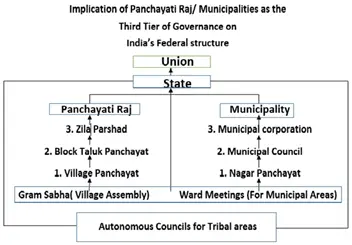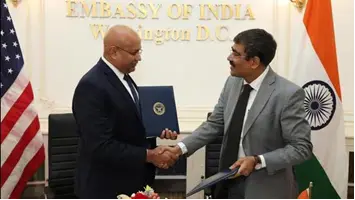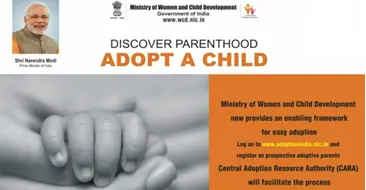Monday, 2nd September 2024
Fertilisers source of diseases; switch to organic farming
Why in the news?
- Recently, Union Home and Cooperation Minister Amit Shah has highlighted that chemicals in fertilisers are linked to various health issues, including hypertension, diabetes, thyroid problems, and cancer.

Organic Farming:
- About:
- FAO: Organic farming is a production management system that promotes and enhances agro-ecosystem health, biodiversity, biological cycles, and soil biological activity.
- FSSAI: Organic farming is a system of farm design and management to create an agricultural ecosystem without synthetic inputs such as chemical fertilisers, pesticides, synthetic hormones, or GMOs.
- Organic Produce: Refers to products obtained from organic agriculture.
- Organic Food: Food products produced according to specified standards for organic production.
- Principles of Organic Farming in India:
- Principle of Health: Focuses on the health of ecosystems, people, and communities, promoting overall well-being.
- Principle of Ecology: Ensures a harmonious balance between ecosystems and the environment, supporting natural processes.
- Principle of Fairness: Emphasises equitable relationships and quality of life for all involved, including fair trade and social justice.
- Principle of Care: Advocates for environmental stewardship and sustainability, considering the future impact on the environment.
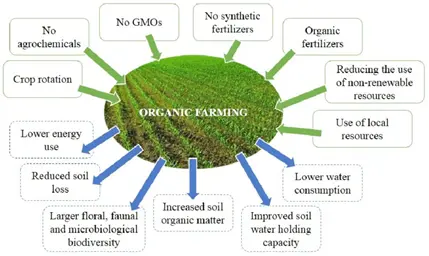
facts about organic farming in India:
- Area under organic certification: As of March 31, 2023, the total area under organic certification was 101.72 lakh hectares.
- Leading states: Chhattisgarh, Madhya Pradesh, Maharashtra, Rajasthan, Gujarat, Himachal Pradesh, and Odisha are the top states for organic farming.
- World ranking: India is fifth in the world for organic farming land.
- Organic production: In 2022-23, India produced 2.9 million metric tonnes of certified organic products.
- Organic farmers: India is the world's top country for the number of organic farmers, with 30% of the world's total.
- First fully organic state: Sikkim was the first state in the world to become fully organic.
- Organic exports: In 2020-21, India exported USD 1.04 billion worth of organic products.
Benefits of Organic Farming:
- Enhanced Soil Fertility: Utilises compost, green manure, and crop rotation to improve soil health and structure over time.
- Pest and Disease Control: Employs natural pest predators and organic pesticides to manage pests without harming beneficial insects or the environment.
- Water Conservation: Promotes better soil water retention, reducing irrigation needs.
- Reduced Greenhouse Gas Emissions: Lower chemical input use leads to decreased carbon and nitrous oxide emissions.
- Improved Farmer Livelihoods: Access to premium markets and reduced input costs can stabilise farmer incomes.
- Health Benefits: Produces food without harmful chemical residues and enhances nutritional quality.
Government Initiatives & Policies:
- Paramparagat Krishi Vikas Yojana (PKVY): Launched in 2015 to promote organic farming in clusters, ensuring uniformity and quality.
- Mission Organic Value Chain Development for Northeastern Region (MOVCDNER): A 2015 initiative to develop the Northeastern region as a hub for organic produce.
- Jaivik Kheti Portal: An online platform launched in 2018 to support organic farming practices and marketing.
- National Programme for Organic Production (NPOP): Established in 2001 to set standards for organic products, certification, and export promotion.
- Organic Certification Systems:
- Participatory Guarantee System (PGS): A farmer-friendly, cost-effective certification system.
- National Certification System for Organic Products (NCSOP): A formal certification system to ensure compliance with organic standards.
Challenges Faced:
- Certification Costs: High and complex certification costs deter small and marginal farmers from adopting organic methods.
- Lack of Awareness and Training: Limited knowledge about organic techniques hampers widespread adoption.
- Market Access: Inadequate infrastructure and market linkages restrict organic farmers' access to premium markets.
- Supply Chain Issues: Poor storage and transportation facilities lead to post-harvest losses, affecting profitability.
- Transition Period: A transition period of two to three years is required to shift from conventional to organic farming, often resulting in reduced yields and financial returns during this period.
Way Forward for Organic Farming in India:
- Technological Upgradation and Research:
- Advancing technology and research in agriculture will enhance organic farming practices, leading to better productivity and reduced reliance on external inputs.
- Integration of Natural Methods:
- Emphasising natural farming methods and collaborating with the international community will help scale and replicate successful practices, connecting organic farmers to the global supply chain.
- Domestic Market Exploitation:
- A comprehensive approach is needed to fully leverage the domestic market for organic products.
- Increasing awareness and compliance with international standards will strengthen India’s position in global agri-trade.
- Policy and Technological Interventions:
- Introducing structural changes through policy and technology will make organic farming more resilient, sustainable, and profitable.
- This includes promoting organic and natural farming in agricultural universities and fostering innovation and entrepreneurship among youth.
|
UPSC Civil Services Examination, Previous Year Questions (PYQs) Prelims Q:1 How is permaculture farming different from conventional chemical farming? (2021)
Select the correct answer using the code given below:
Ans: (b)
Q:2 With references to organic farming in India, consider the following statements: (2018)
Which of the statements given above is/are correct?
Ans: B
Mains: Q:1 What are the present challenges before crop diversification? How do emerging technologies provide an opportunity for crop diversification? (2021) Q:2 How has India benefited from the contributions of Sir M. Visvesvaraya and Dr. M. S. Swaminathan in the fields of water engineering and agricultural science respectively? (2019) |
Source: TH
A Game Plan for India’s Success as 2036 Olympic Host
Why in the news?
- Recently, during his Independence Day address from the Red Fort this August, PM Narendra Modi announced India’s aspiration to host the 2036 Olympic Games.
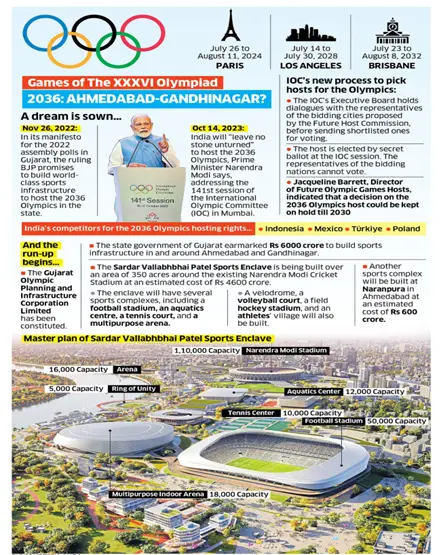
Challenges of Hosting the Olympics:
- Infrastructure Requirements:
- Construction and Refurbishment: Developing and upgrading sports venues to meet Olympic standards, including an Olympic Village and accommodations for athletes, media, and tourists.
- Facility Adaptability: Ensuring that venues are suitable for various sports and can accommodate diverse needs.
- Financial Investment:
- High Costs: Expenses for new and upgraded facilities, and preparing the city for millions of visitors can be substantial. Example: Tokyo 2020's budget soared from $7.3 billion to over $15 billion.
- Uncertain Economic Impact: While tourism and global visibility may boost the economy, recouping the investment is often challenging.
- Logistical and Operational Complexities:
- Coordination Challenges: Managing event schedules, athlete logistics, and communication with international sports bodies and the IOC.
- Risk of Disruptions: Mismanagement can lead to disruptions or cancellations, affecting the host city’s reputation.
- Cultural and Social Integration:
- Global Representation: Balancing the promotion of local culture with the celebration of global diversity in ceremonies and events.
- Inclusivity: Ensuring accessibility and a welcoming environment for people from various backgrounds.
- Global Expectations and Diplomatic Relations:
- International Scrutiny: The host city is under global scrutiny, and any failure can impact diplomatic relations and international perceptions.
- Navigating Geopolitics: Managing complex geopolitical issues while ensuring fair treatment of all participating nations.
India’s Journey Towards Olympic Ambition
- Post-2010 Commonwealth Games: India began focusing on improving sports infrastructure and governance.
- Khelo India Scheme (2017): Aims at upgrading sports facilities, developing talent, and promoting sports academies.
- Success Stories: At the 2024 Paris Olympics, 28 athletes participated from the Khelo India program, showcasing its impact.
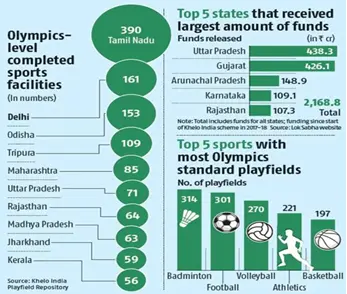
How India Can Successfully Bid for the 2036 Olympics:
- Leveraging State Infrastructure:
- State Contributions: Utilise existing sports facilities in states like Tamil Nadu, Delhi, and Odisha, which already have nearly 390, 161, and 153 Olympic-standard facilities respectively.
- Cost Efficiency: Capitalise on existing venues and facilities to reduce costs and enhance eco-friendliness.
- Cost-Efficient and Eco-Friendly Bid:
- Sustainability Focus: Emphasise the use of renewable energy, sustainable construction practices, and waste management innovations.
- Showcase Achievements: Highlight the success of the Khelo India program and India’s rising international sports profile.
- Building a National Consensus:
- Collaborative Approach: Involve state governments, sports associations, and the central government in the bid process.
- Leadership: Ensure high-level support from the Union government for a unified and effective bid.
- Compelling Case to the IOC:
- Infrastructure and Sustainability: Present the existing facilities and plans for an eco-friendly Olympics.
- Sports Development: Use recent sports achievements to demonstrate commitment to nurturing athletic talent from grassroots to elite levels.
Conclusion
India's bid to host the 2036 Olympics represents a significant ambition reflecting its growing confidence and capabilities. The success of the bid will depend on addressing the challenges of infrastructure, financial investment, logistics, cultural integration, and diplomatic relations, while leveraging existing facilities and showcasing a commitment to sustainability and sports development.
Source: TH
Global Fintech Fest (GFF) 2024
Why in the news?
- Recently, Prime Minister Narendra Modi addressed the Global Fintech Fest (GFF) 2024 at the Jio World Convention Centre in Mumbai, Maharashtra.
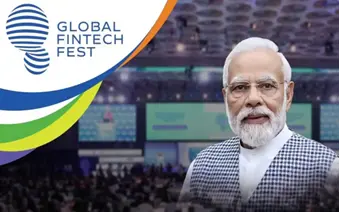
Global Fintech Fest (GFF):
- About:
- Organisers: The event is jointly organised by the Payments Council of India, the National Payments Corporation of India, and the Fintech Convergence Council.
- Objective: The fest aims to showcase India’s advancements in Fintech and to bring together key stakeholders in the sector.
Fintech:
- About Fintech:
- Definition: Fintech, or financial technology, refers to the use of technology to deliver financial services more efficiently, accessibly, and user-friendly.
- Scope: It includes a broad range of innovations aimed at improving and automating the delivery and use of financial services, often through digital platforms.
- Applications of Fintech:
- Digital Payments: Platforms enabling online or mobile financial transactions, such as UPI and Google Pay.
- Lending and Borrowing: Online platforms providing loans using data-driven algorithms to assess creditworthiness, including peer-to-peer lending and digital loan apps.
- Wealth Tech: Tools for investment management and financial planning, such as robo-advisors and digital asset management platforms.
- Blockchain and Cryptocurrency: Technologies enabling secure, decentralised financial transactions, including cryptocurrencies like Bitcoin.
- Regtech: Technologies helping financial institutions comply with regulations efficiently, often using AI and big data.
- Neo banking: Digital-only banks offering banking services without physical branches, typically through mobile apps or online platforms.
- Benefits of Fintech:
- Financial Inclusion:
- Fintech has extended banking and financial services to underserved and unbanked populations, particularly in rural and remote areas.
- Mobile banking, digital wallets, and micro-lending platforms have empowered millions, allowing them to participate in the formal economy.
- Job Creation and Economic Growth:
- The fintech sector is a significant driver of job creation in India, offering opportunities in technology, finance, marketing, and customer service.
- As the sector grows, it stimulates economic development by supporting small and medium-sized enterprises (SMEs) and improving business efficiency.
- Digital Payments Revolution:
- India’s fintech revolution is exemplified by the widespread adoption of digital payments, enhancing transparency, reducing corruption, and securing financial transactions.
- Impact on Urban and Rural Divide:
- Fintech has bridged the urban-rural divide by providing equal access to financial services, promoting economic equity, and reducing regional disparities.
- Financial Inclusion:
- Concerns:
- Fintech Companies and Money Laundering: A Parliamentary Committee has highlighted concerns over fintech companies being exploited for money laundering, citing instances such as the Abu Dhabi-based app Pyppl, administered by Chinese investment scamsters.
- Fraud Trends and Ratio: Despite an increase in transaction volume, the ratio of fraudulent transactions remains relatively low.
- Impact on UPI Users: The percentage of UPI users affected by fraud is 0.0189%, indicating that the overall impact on users remains low compared to the total volume of transactions.
Key Highlights of PM Modi’s Speech at GFF 2024
- India's Fintech Revolution:
- Global Recognition: India’s fintech diversity is now as impressive as its cultural diversity, attracting global attention.
- Investment and Growth: The sector has attracted over $31 billion in investments over the past decade, with a 500% growth in startups.
- Infrastructure Development: The increase in broadband users from 60 million to 940 million, along with the widespread adoption of Aadhaar and Jan Dhan accounts, has driven this revolution.
- Jan Dhan, Aadhaar, and Mobile Trinity:
- Digital Transactions: The integration of Jan Dhan accounts, Aadhaar, and mobile technology has facilitated half of the world’s digital transactions in India.
- Impact of UPI: The Unified Payments Interface (UPI) has revolutionised 24/7 banking, even in rural areas.
- Financial Empowerment:
- Women Empowerment: The Jan Dhan Yojana has empowered women with over 29 crore bank accounts, significantly benefiting rural women through self-help groups.
- Mudra Yojana: The scheme has disbursed Rs 27 trillion, benefiting 70% women, showcasing fintech’s role in financial inclusion.
- Transparency and Governance:
- Curbing Parallel Economy: Fintech has introduced transparency in financial transactions, especially through Direct Benefit Transfer (DBT) in government schemes, reducing leakages.
- Social Impact of Fintech:
- Urban-Rural Gap Bridging: Fintech has transformed access to financial services, enabling farmers, fishermen, and middle-class families to manage finances through mobile phones.
- Democratisation of Financial Services: Fintech has made credit, investments, and insurance more accessible, benefiting small vendors through schemes like PM SVANidhi.
- Advancements in Digital Banking:
- Neo banking and Digital-Only Banks: Modern concepts like neo banking and the shift from currency to QR codes were discussed, highlighting innovations such as Digital Twins technology and the Open Network for Digital Commerce (ONDC).
- Account Aggregators and e-RUPI: These tools are enhancing financial management for small businesses and have global applicability.
- Cybersecurity and Regulation:
- Policy Support: The government supports fintech growth by removing the Angel Tax, investing in research, and implementing the Digital Personal Data Protection Act.
- Cyber Fraud: The importance of digital literacy and robust regulatory measures to combat cyber fraud was emphasised.
- Sustainable Economic Growth:
- Green Finance: The government prioritises sustainable growth, focusing on green finance and financial inclusion to strengthen markets with advanced technologies.
- Future Outlook: PM Modi expressed confidence in the future of India’s fintech ecosystem, predicting it will significantly enhance the quality of life globally, and committed to participating in the 10th edition of GFF.
|
UPSC Civil Services Examination, Previous Year Question (PYQ) Prelims Q:1 With reference to India, consider the following: (2010)
Which of the above can be considered as steps taken to achieve the “financial inclusion” in India?
Ans: (d)
Mains: Q:1 Pradhan Mantri Jan Dhan Yojana (PMJDY) is necessary for bringing unbanked to the institutional finance fold. Do you agree with this for financial inclusion of the poorer section of the Indian society? Give arguments to justify your opinion. (2016) |
Source: BS
RBI’s Report on the Economy’s Performance so Far in 2024-25
Why in the news?
- Recently, The Reserve Bank of India (RBI) has released the first official gauge of the economy’s performance for 2024-25.

Key Highlights of the RBI’s Report:
- Gross Domestic Product (GDP) Growth:
- The RBI recently revised its Q1 GDP forecast for 2024-25 from 7.2% to 7.1%.
- Despite this revision, the RBI projects a 7.2% GDP growth for the entire fiscal year 2024-25, following an 8.2% growth in the previous year.
- Growth in Gross Value Added (GVA):
- For the first time in a year, growth in real GVA outpaced GDP growth, with a 6.8% increase in Q1 of 2024-25.
- This GVA growth was primarily driven by an 8.4% surge in the Secondary Sector, including construction, utility services (electricity, gas, water supply), and manufacturing.
- Employment Generation:
- India provisionally created 46.7 million jobs in the financial year ending March 2024, bringing total employment to 643.3 million.
- The employment growth rate increased to 6% in this fiscal year, compared to 3.2% in the previous year.
- Bank Credit Growth:
- Credit to agriculture and allied activities remained strong, with an 18.1% growth, reaching Rs 21.55 lakh crore in July 2024, compared to 16.7% growth a year ago.
- Credit growth to industry also strengthened significantly, recording a 10.2% increase to Rs 37.05 lakh crore in July 2024, up from 4.6% in July 2023.
- However, credit growth to the services sector moderated to 15.4% in July 2024 from 19.7% a year earlier, mainly due to lower credit growth in non-banking financial companies (NBFCs) and trade segments.
- Bright Spots in India’s Economic Performance:
- Normal Monsoon Impact: A favourable monsoon is boosting agricultural productivity, stabilising food prices, and invigorating rural demand, which aids overall economic growth.
- Private Investment Uptick: Rising demand is encouraging private sector investment, reducing reliance on government spending, and fostering balanced economic expansion.
- Robust Credit Growth: Significant growth in bank credit to agriculture and industry is driving rural and urban economic resilience.
- Employment Growth: A 6% employment growth rate in FY 2023-24, with 46.7 million jobs created, strengthens the labour market and boosts consumer spending.
- Challenges and Way Ahead for the Indian Economy:
- Public Capital Expenditure Constraints: The prolonged general election has slowed public capital expenditure. To meet spending targets, the government must intensify efforts to accelerate public investments.
- Need for Meaningful Reforms: Urgent reforms are necessary across various economic sectors, including improving institutional efficiency and judicial processes, to enhance the country's growth potential.
- Employment Generation: To capitalise on India's demographic dividend, policies must focus on creating gainful employment at a pace that matches the growing workforce.
- Balancing Inflation and Growth: Managing inflation while sustaining economic growth remains a critical challenge, especially in the context of global economic uncertainties.
Source: TH
Dumping duty on Chinese aluminium foil imports
Why in the news?
- Recently, The Directorate General of Trade Remedies (DGTR) recommended imposing an anti-dumping duty on aluminium foil imported from China after surging shipments from the neighbouring country captured nearly a third of India's market share despite ample local production capacity.
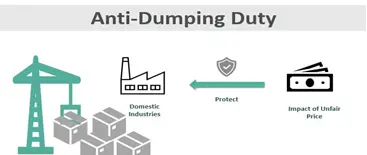
- It recommended a duty between $619 and $873 per metric ton on foil up to 80 microns thick, excluding aluminium foil below 5.5 microns for non-capacitor application.
Anti-Dumping Duty:
- About:
- A protective tariff imposed by a government on foreign imports believed to be priced below fair market value.
- Dumping occurs when a company exports a product at a price significantly lower than its domestic market price.
- Purpose:
- To protect domestic businesses from unfair competition by correcting the trade-distorting effects of dumping and ensuring fair trade.
- Implementation:
- The duty amount equals the difference between the normal costs in the importing country and the market value of similar goods in the exporting country.
- The World Trade Organization (WTO) permits anti-dumping duties if there is evidence of material injury to the domestic market.
- Effects:
- Protects local businesses but can lead to higher prices for domestic consumers.
- In India, the Ministry of Finance makes the final decision on imposing anti-dumping duties.
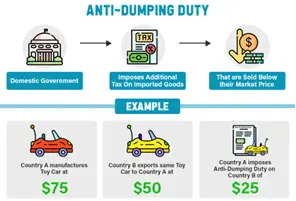
Countervailing Duty (CVD):
- About: An import tax imposed to counteract the negative impact of foreign subsidies that make imported products cheaper.
- Purpose: To neutralise the price advantage of subsidised imports and protect domestic producers from unfair competition.
- Implementation: Imposed when foreign governments provide subsidies to their producers, making their products cheaper. The duty matches the subsidy amount to level the playing field.
- Comparison with Anti-Dumping Duty:
- Anti-Dumping Duty: Applied to foreign goods priced below fair market value.
- CVD: Applied to foreign goods benefiting from subsidies that lower their prices.
- Calculation: Anti-dumping duty is based on the margin of dumping, while CVD is based on the value of the subsidy.
Challenges for Anti-Dumping and Countervailing Duties:
- Impact on Domestic Consumers:
- Higher Prices: Both anti-dumping and countervailing duties can lead to increased prices for domestic consumers, potentially reducing their purchasing power and affecting overall consumption.
- Reduced Choices: Higher import tariffs can limit the variety of products available to consumers, impacting their choice and quality of goods.
- Trade Relations:
- Retaliation Risks: Imposing these duties may provoke retaliatory measures from exporting countries, potentially leading to trade disputes or trade wars.
- WTO Disputes: Disagreements over the imposition of these duties can lead to disputes within the WTO, which could result in sanctions or penalties.
- Administrative Burden:
- Complex Procedures: Determining the extent of dumping or subsidies involves detailed investigations and can be administratively intensive and time-consuming.
- Compliance Costs: Both domestic industries and foreign exporters face increased costs related to compliance with anti-dumping and countervailing duties.
Way Forward:
- Enhanced Monitoring and Review:
- Regular Assessments: Conduct periodic reviews of imposed duties to ensure they are still necessary and effective in addressing trade distortions.
- Transparency: Ensure transparency in the investigation and imposition processes to build trust and reduce disputes.
- Strengthening Trade Relations:
- Negotiations: Engage in diplomatic negotiations with trading partners to resolve disputes amicably and avoid escalating trade tensions.
- WTO Compliance: Adhere to WTO guidelines and dispute resolution mechanisms to manage trade issues fairly and effectively.
- Support for Affected Industries:
- Subsidy Programs: Implement domestic support programs to help industries adjust to new trade conditions and enhance their competitiveness.
- Consumer Protection: Provide measures to mitigate the impact on consumers, such as subsidies or price controls on essential goods.
- Policy Coordination:
- Integrated Trade Policies: Align anti-dumping and countervailing measures with broader trade and economic policies to ensure coherence and support overall economic goals.
- International Collaboration: Work with international bodies and trade partners to develop fair and effective trade practices that benefit all parties involved.
Source: TH
Dispute Resolution Scheme
Why in the news?
- Recently, The Central Board of Direct Taxes (CBDT) has introduced the Dispute Resolution Scheme (e-DRS), 2022, as a streamlined and efficient platform for taxpayers to resolve their income tax disputes.
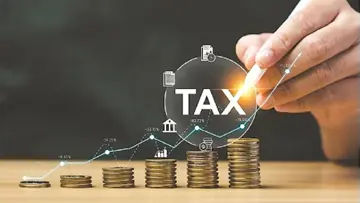
Dispute Resolution Scheme (e-DRS), 2022
- About:
- The Dispute Resolution Scheme (e-DRS), 2022, introduced by the CBDT, serves as a streamlined platform designed to expedite and simplify the resolution of income tax disputes.
- Key Features:
- Objective: The scheme is aimed at reducing litigation and offering taxpayers a quicker, cost-effective means of resolving disputes.
- Legal Basis: The scheme is established under Section 245 MA of the Income-tax Act, 1961, enabling electronic resolution of disputes through Dispute Resolution Committees (DRCs).
- Eligibility Criteria:
- Taxpayers eligible for the scheme must meet specific conditions outlined in Section 245 MA.
- Financial Thresholds: The disputed amount must not exceed Rs. 10 lakh, and the taxpayer’s income for the relevant year should be below Rs. 50 lakhs.
- Exclusions: Disputes involving information from searches or international agreements are not eligible under this scheme.
- Functioning of DRCs:
- The DRCs are operational across 18 regions in India, with the authority to modify orders, reduce penalties, or waive prosecution as necessary.
- Timeframe: DRCs are mandated to deliver their decisions within six months of receiving an application, ensuring a prompt resolution process.
Source: PIB
Metal-organic framework
Why in the news?
- Researchers have recently developed electrochemical and optical biosensors using nano-polymers, multifunctional Metal-Organic Frameworks (MOFs), and 2-dimensional (2D) materials.
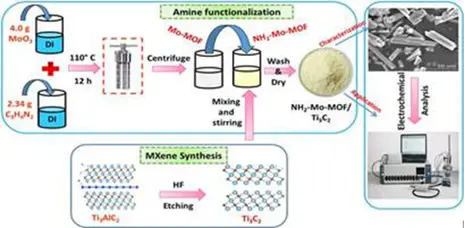
Metal-Organic Frameworks (MOFs):
- About:
- Structure and Composition: MOFs are uniform, structured porous materials, making them ideal for solid-phase extraction. They are multifunctional coordination polymers, offering versatility in various applications.
- 2-Dimensional (2D) Materials:
- Definition: 2D materials are a class of nanomaterials characterised by their extremely thin structure, often being just one or two atoms thick.
- Unique Features: MOFs and 2D materials are distinguished by their large surface area, functionality, and optoelectronic properties, making them superior to other nanomaterials in sensor applications.
- Synthesis and Development: These materials offer a wide range of synthesis methods and can be developed into various sensor types, including disposable electrodes, optical kits, fibre optic sensors, and colorimetric strips.
- Applications:
- Sensor Development: MOFs and 2D materials are utilised in creating electrochemical and optical sensors for detecting various analytes, such as bacteria, aflatoxins, and heavy metals.
- Health, Food, and Environmental Monitoring: These materials facilitate the rapid and convenient detection of health indicators, food quality, and environmental parameters.
- Food Toxin Analysis: MOFs and 2D materials are particularly useful for analysing food toxins, including aflatoxins and zearalenone, in water, milk, and staple food samples.
Source: PIB
Fluoxetine
Why in the news?
- A recent study has revealed that long-term exposure to fluoxetine (commonly known as Prozac) can significantly disrupt the behaviour and reproductive traits of male guppy fish.

What is Fluoxetine?
- About
- Nature and Use:
- Fluoxetine is a widely used antidepressant medication.
- It functions by inhibiting the reuptake of serotonin by neurons, thereby helping individuals with depression, panic disorder, anxiety, or obsessive-compulsive symptoms.
- Nature and Use:
- Effects of Fluoxetine:
- Behavioural Impact:
- At low concentrations, fluoxetine reduces activity levels and increases refuge-seeking behaviour in male guppy fish.
- This could lead to changes in their typical behaviour patterns, affecting their ability to adapt to environmental changes.
- Reproductive Impact:
- Fluoxetine exposure alters the body condition of male guppies, increases the size of their reproductive organs, and reduces sperm velocity.
- These changes could negatively impact mating success and reproductive fitness in environments contaminated with the drug.
- Behavioural Plasticity:
- The exposure to fluoxetine reduces behavioural plasticity in guppies, suppressing within-individual variation in activity and refuge-seeking behaviour.
- This rigidity in behaviour may limit their ability to respond flexibly to environmental changes.
- Variations Due to Concentration:
- High concentrations of fluoxetine increased variation in body condition among individual guppies, while low concentrations led to increased variation in sperm numbers.
- Behavioural Impact:
- Key Facts About Guppy Fish:
- General Description:
- Guppy fish are small, colourful species that are extremely popular in-home aquariums.
- They are tropical freshwater fish known for their vibrant colours.
- Sexual Dimorphism:
- Guppies exhibit sexual dimorphism, with distinct differences between males and females.
- Male guppies are brightly coloured in shades of black, green, orange, red, white, and yellow, often featuring patterns such as speckles, spots, and stripes.
- Distribution:
- Guppies are native to specific regions in South America, including Antigua and Barbuda, Barbados, Brazil, Guyana, Suriname, Trinidad and Tobago, and Venezuela.
- General Description:
Source: DTE
Poba Reserve Forest
Why in the news?
- The Poba Reserve Forest, located in Assam’s Dhemaji district, is set to be notified as a wildlife sanctuary.
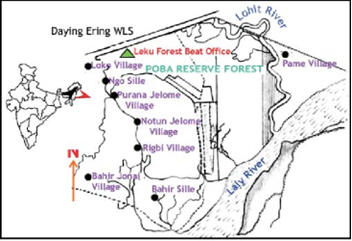
About Poba Reserve Forest:
- Location: Situated in the northeastern part of Assam, the Poba Reserve Forest is a rainforest that was established as a Reserved Forest (RF) in 1924, covering an area of 10,221 hectares.
- Boundaries:
- North: Foothills of the Himalayan range in Arunachal Pradesh.
- East and South: Confluence of the Siang, Dibang, and Lohit River systems into the Brahmaputra and proximity to Dibru-Saikhowa National Park.
- West: Revenue villages of the Jonai Sub-division in Dhemaji district.
- Ethnic Inhabitants: The periphery of the reserve forest is inhabited by ethnic groups such as the Missing, Bodo, Sonowal Kachari, and Hajong (Rabha).
- Biodiversity:
- One of the richest rainforests in North-East India, housing diverse flora and fauna.
- Mammals: Includes species like the slow loris, capped langur, and wild boar.
- Birds and Reptiles: Home to about 45 species of birds and reptiles.
- Fish: The confluence of the Siang and Lohit rivers supports various fish species.
- Orchids: The forest is renowned for its variety of orchids.
- Ecological Importance:
- Serves as a crucial migratory route for animals, especially elephants, connecting the D' Ering Memorial Wildlife Sanctuary (Arunachal Pradesh), Kabu Chapri Proposed Reserve Forest, and Dibru-Saikhowa National Park (Assam).
- This corridor is the second significant elephant migration route from the north to the south bank of the Brahmaputra River, with the first being the Panpur-Kaziranga route.
Source: TI
Bank privatisation in India
Context:
- At a recent FICCI forum, the Chairman of the 16th Finance Commission emphasised that privatising banks is a crucial reform to address the persistent issue of non-performing assets (NPAs) in India.
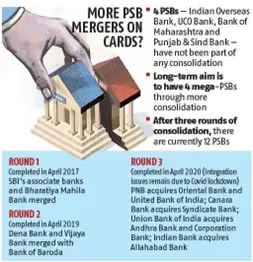
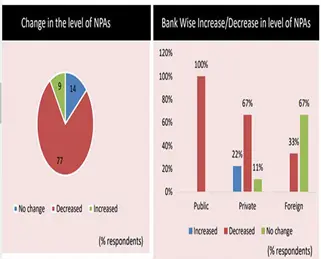
About the Privatisation of Banks in India
- Definition: Privatisation involves transferring ownership, control, or property of a business or entity from the government to the private sector.
- Current Consideration: The Indian government is exploring the privatisation of public sector banks (PSBs) as part of wider economic reforms aimed at boosting efficiency, enhancing governance, and attracting private investment.
- Debate: Proponents argue that it can lead to improved efficiency and governance, while critics highlight that state-owned banks offer stability and contribute to economic growth and financial inclusion.
- State-Owned Banks: These banks provide stability and support economic growth and financial inclusion. Their role extends beyond profit-making, ensuring broader economic stability.
- Private Banks: These institutions focus on profit, which can sometimes result in riskier behaviour and short-term decision-making.
Background:
- Nationalisation History:
- In 1969, the Indian government nationalised 14 major private banks to align the banking sector with the socialist policies of the time.
- The State Bank of India (SBI) was nationalised earlier in 1955, followed by the insurance sector in 1956.
- Previous Government Stances:
- Over the past two decades, various governments have fluctuated between supporting and opposing the privatisation of Public Sector Undertaking (PSU) banks.
- In 2015, although privatisation was proposed, the then Reserve Bank of India (RBI) Governor opposed it.
- Current Approach:
- Recent moves include privatisation plans, and the establishment of an Asset Reconstruction Company (Bad Bank) owned by banks.
- These steps aim to find market-driven solutions to financial sector issues.
- Legislative Action:
- The 2021-22 Budget announced the privatisation of two public sector banks, but the government has yet to amend the banking laws required to sell its majority stake.
Reasons for Privatisation:
- Degrading Financial Position of Public Sector Banks: Despite capital injections and governance reforms, PSBs continue to have high levels of stressed assets, lower profitability, and less favourable market capitalization and dividend records compared to private banks.
- Long-Term Project: The initial plan involves privatising four PSBs, with a gradual approach based on the success of the first two. This aims to reduce the government's equity support and consolidate the number of state-owned banks from 28 to 12.
- Strengthening Banks: The government seeks to bolster strong banks while reducing their numbers through privatisation, which would alleviate its support burden.
- Committee Recommendations: Various committees have recommended reducing government stakes in public banks:
- The Narasimham Committee proposed reducing the stake to 33%.
- The P J Nayak Committee suggested lowering it below 50%.
- An RBI Working Group recently advocated for business houses to enter the banking sector.
- Creation of Big Banks: Privatisation aims to create larger banks by merging PSBs with big private banks, thereby enhancing their scale, risk appetite, and lending capacity. This multifaceted approach seeks to develop a more sustainable and robust banking system.
Policy Considerations:
- Narasimham Committee-I (1991):
- Reformed banking structure with a 4-tier system.
- Proposed a quasi-autonomous body under the RBI for supervision.
- Advocated deregulation of interest rates, full disclosure of accounts, and creation of an Asset Reconstruction Fund.
- Narasimham Committee-II (1998):
- Suggested merging major public sector banks to boost international trade.
- Introduced “Narrow Banking” for banks with high NPAs.
- Recommended reforms in the RBI’s regulatory role.
- Recent Push for Privatisation
- Profitability and Consolidation:
- Consolidation has led to fewer but larger and profitable PSBs.
- Policymakers aim to privatise a more efficient banking system.
- Equitable Growth:
- Nationalised banks supported regional growth, rural development, and key economic revolutions (green, blue, dairy).
- Profitability and Consolidation:
- Recent Developments
- Privatisation Plans (2021):
- Budget for FY 2021-22 announced privatisation of two PSBs to enhance efficiency and autonomy. Specific banks for privatisation are pending.
- RBI’s Acceptance of Recommendations (2021):
- RBI accepted 21 out of 33 recommendations from an internal working group.
- Recommendations included raising promoters' stake cap from 15% to 26% over 15 years and implementing a fit and proper control mechanism.
- Privatisation Plans (2021):
Arguments Favouring Bank Privatisation:
- Efficiency and Profitability:
- Private banks, driven by profit motives, are often seen as more efficient with streamlined operations and better financial performance.
- Public banks, however, excel in financial inclusion by reaching underserved regions and marginalised groups.
- Government’s Monopoly:
- Government ownership in PSBs accounts for nearly 70% of banking assets, leading to reduced competition and inefficiency.
- Previous Experience:
- Strategic disinvestment has historically led to efficiency gains and higher returns for shareholders.
- Potential for leveraging microfinance institutions (MFIs) and new private banks (NPBs) for social programs like DBT and PMJDY.
- Reduced Burden on Public Exchequer:
- Privatisation could alleviate the need for government recapitalisation to meet Basel III requirements, thus reducing fiscal strain.
Arguments Against Bank Privatisation:
- Monopoly Concerns:
- Privatisation might lead to concentration, cartelization, and reduced competition, impacting the affordability and accessibility of banking services.
- PSBs play a vital role in serving vulnerable sections, rural areas, and priority sectors.
- Financial Exclusion:
- Private banks might focus on profitable urban areas, neglecting rural and underserved regions, whereas PSBs provide crucial services to remote and marginalised communities.
- Security Concerns:
- Privatisation could remove the sovereign guarantee behind PSB deposits, potentially reducing trust and security in household savings.
- Underreporting of NPAs:
- Both private and public banks have historically underreported NPAs. Critics argue privatisation may worsen this issue due to incentives for private banks to downplay NPAs.
- Monopoly and Cartelisation Risks:
- Concentration of banking power in a few private entities may lead to monopolistic practices, reducing competition and potentially increasing fees.
- Case Study: Bank Failures in the US:
- The US, with a predominantly private banking sector, has seen significant bank failures, suggesting that privatisation does not guarantee stability or success.
Way Forward:
- Selective Approach:
- The government plans to focus on smaller PSBs for privatisation, excluding major banks like SBI, PNB, and Bank of Baroda.
- This approach aims to improve efficiency while preserving the social mandate of larger institutions.
- Regulatory Vigilance:
- Regardless of ownership, maintaining robust regulatory oversight is essential. The RBI must ensure stability, transparency, and prudent lending practices to safeguard the banking system.
- Public-Private Partnership:
- A hybrid model could be considered, where PSBs retain their social objectives but collaborate with private players to enhance efficiency and performance.
- Balancing Reform and Stability:
- While addressing NPAs is important, preserving a stable banking system is equally crucial.
- Reforms can be implemented without full privatisation, ensuring that state-owned banks continue to serve public interests effectively.
- Overall, Balance:
- The privatisation of banks requires a careful balance between enhancing efficiency, ensuring accountability, and protecting public interests.
- Achieving this balance is critical to advancing India's banking sector reforms.
|
UPSC Civil Services Examination, Previous Year Question Prelims Q:1 In the context of governance, consider the following: (2010)
Which of the above can be used as measures to control the fiscal deficit in India?
Ans: (d)
Q:2 With reference to the governance of public sector banking in India, consider the following statements: (2018)
Which of the statements given above is/are correct?
Ans: (b)
Mains Q:1 Pradhan Mantri Jan Dhan Yojana (PMJDY) is necessary for bringing the unbanked to the institutional finance fold. Do you agree with this for financial inclusion of the poorer section of the Indian society? Give arguments to justify your opinion (2016) |
Source: TH
Share the article
Edukemy’s Current Affairs Quiz is published with multiple choice questions for UPSC exams
MCQ
Get Latest Updates on Offers, Event dates, and free Mentorship sessions.

Get in touch with our Expert Academic Counsellors 👋
FAQs
UPSC Daily Current Affairs focuses on learning current events on a daily basis. An aspirant needs to study regular and updated information about current events, news, and relevant topics that are important for UPSC aspirants. It covers national and international affairs, government policies, socio-economic issues, science and technology advancements, and more.
UPSC Daily Current Affairs provides aspirants with a concise and comprehensive overview of the latest happenings and developments across various fields. It helps aspirants stay updated with current affairs and provides them with valuable insights and analysis, which are essential for answering questions in the UPSC examinations. It enhances their knowledge, analytical skills, and ability to connect current affairs with the UPSC syllabus.
UPSC Daily Current Affairs covers a wide range of topics, including politics, economics, science and technology, environment, social issues, governance, international relations, and more. It offers news summaries, in-depth analyses, editorials, opinion pieces, and relevant study materials. It also provides practice questions and quizzes to help aspirants test their understanding of current affairs.
Edukemy's UPSC Daily Current Affairs can be accessed through:
- UPSC Daily Current Affairs can be accessed through Current Affairs tab at the top of the Main Page of Edukemy.
- Edukemy Mobile app: The Daily Current Affairs can also be access through Edukemy Mobile App.
- Social media: Follow Edukemy’s official social media accounts or pages that provide UPSC Daily Current Affairs updates, including Facebook, Twitter, or Telegram channels.

